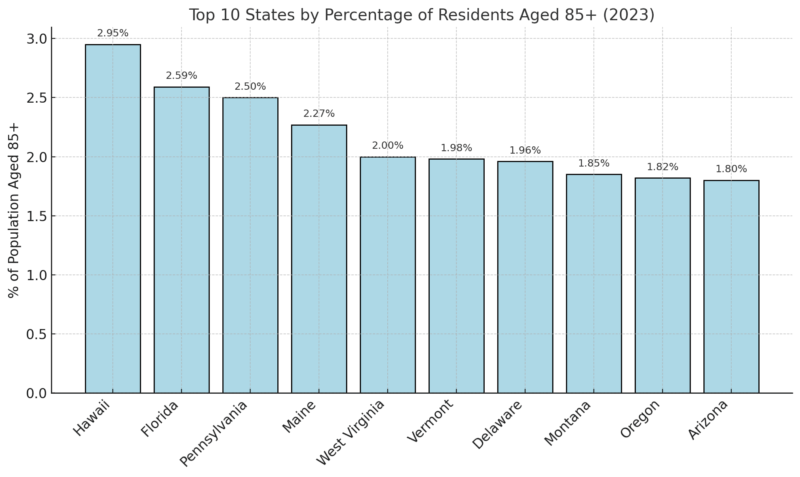According to the U.S. Census Bureau’s 2020 estimates, over 55 million Americans were aged 65 or older. That figure represents about 16.5% of the total U.S. population at the time.
Of this group, over 6.3 million were aged 85 and above, a number projected to rise significantly in the coming decades.
By 2050, the number of Americans aged 65+ is expected to grow by 47%, reaching over 82 million, according to the Population Reference Bureau. The fastest growth will occur in the 85+ age bracket, a trend confirmed by multiple longitudinal datasets and reflected in public healthcare policy planning.
Table of Contents
ToggleTop 10 States by Percentage of Residents Aged 85+
While populous states like California and Florida have the largest number of older residents, smaller states often have higher proportions of people aged 85+.
According to analyses from the U.S. Census Bureau and recent reports from Opera Beds and Northwell Health/Stacker, the following states lead in this category:

According to the AQLI, Hawaii leads the nation not only in terms of average life expectancy but also in the concentration of people aged 85 and older, likely due to a combination of genetics, diet, and social cohesion.
Florida and Pennsylvania follow closely, benefiting from large retirement communities and stable aging-in-place trends.
Absolute Numbers of Seniors Aged 65+ and Implications for the 85+ Population
While the percentage provides a useful ratio, absolute numbers help understand the real impact on services and infrastructure. The 10 states with the largest total populations of people aged 65 and older also house a large share of the nation’s 85+ population.
According to Lillian Kilduff’s 2021 analysis of Census Bureau data:
| Rank | State | Population 65+ (2020, thousands) | % of State Pop |
| 1 | California | 5,976 | 15.2% |
| 2 | Florida | 4,638 | 21.3% |
| 3 | Texas | 3,874 | 13.2% |
| 4 | New York | 3,370 | 17.4% |
| 5 | Pennsylvania | 2,448 | 19.1% |
| 6 | Ohio | 2,098 | 17.9% |
| 7 | Illinois | 2,089 | 16.6% |
| 8 | Michigan | 1,812 | 18.2% |
| 9 | North Carolina | 1,815 | 17.1% |
| 10 | Georgia | 1,575 | 14.7% |
Florida stands out by being in the top tier both in absolute numbers and in percentage, with over 4.6 million residents aged 65+, nearly 1 million of whom are estimated to be over 85, according to EDR.
Pennsylvania also shows this dual status due to aging-in-place trends in the Northeast.
Growth Rate of the 85+ Population Over Time
States with fast-growing elderly populations are often different from those with the highest current shares. According to the Opera Beds study comparing data from 2003 to 2023:
- Nevada saw a 127% increase in its 85+ population.
- Alaska followed closely with 122% growth.
- Hawaii experienced a 100% increase.
These increases are due to a combination of longer life expectancy, migration, and better healthcare systems. As noted by the Population Reference Bureau, most growth in the 85+ population is yet to come as Baby Boomers continue to enter their mid-80s.
What Drives These Demographic Patterns?

1. Migration Trends
Demographic aging across the United States is shaped as much by migration flows as by biology. The shifting movement of both older and younger populations plays a central role in determining which states now have the highest shares of people aged 85 and older.
According to the U.S. Census Bureau and health studies by Northwell Health, states like Florida, Arizona, and South Carolina have long been identified as retirement magnets. Their appeal comes down to a predictable set of advantages:
- No state income tax (Florida)
- Warmer, drier winters
- Senior-friendly housing developments
- Access to high-density healthcare systems
- Low cost of living compared to coastal metros
As a result, these states attract large numbers of retirees each year. In Florida alone, more than 4.6 million residents were aged 65+ in 2020, and a significant portion of them are now advancing into the 85+ category.
This influx has rapidly increased the absolute number of very old adults and created pressure on long-term care infrastructure, from assisted living to memory care.
But in contrast to these in-migration states, regions like Maine, Vermont, West Virginia, and Pennsylvania have experienced a different kind of demographic aging, caused not by the in-migration of retirees, but by the out-migration of younger adults.
For example:
- In Maine, while the total population has stayed relatively stable, the under-35 population declined steadily between 2000 and 2020. As younger generations leave in search of jobs, education, or more affordable housing in urban hubs, they leave behind aging parents and grandparents.
- This aging-in-place dynamic means that even states with modest economic growth or limited retirement appeal still see their median age rising sharply.
Such patterns contribute to a more “organic” aging process, where a state like Pennsylvania ends up with 324,000 residents aged 85+ (2020 estimate), not because it’s drawing retirees, but because residents are simply living longer and staying.
This also has legal implications. As abuse and neglect complaints in care facilities rise, legal support systems are growing in importance. According to nursinghomelawcenter.org, the demand for elder law attorneys and elder abuse litigation—particularly in high-density eldercare zones like Los Angeles, Florida, and Phoenix—has increased sharply in the past five years.
2. Life Expectancy and Longevity
A second and powerful driver of the growth in the 85+ population is the simple fact that Americans are living longer than ever before, especially in states where healthcare systems, lifestyle, and environment are particularly supportive.
Take Hawaii, for example. According to 2022 data from Stanford University, the state had the highest life expectancy in the country at 81.3 years. In practice, this means that many Hawaiians not only reach retirement age, but often live well into their 90s and beyond.
In fact, 0.24% of the population of Hawai‘i is already aged 100 or older, the highest share in the nation, according to the 2022 Social Security Administration.
What’s contributing to this remarkable longevity?
- Traditional diets rich in fish, vegetables, and low-processed ingredients
- Strong family structures and social support networks
- High-quality healthcare access, particularly for veterans and low-income seniors
- Lower rates of smoking and obesity compared to mainland averages
JMIR (2024) also emphasizes the importance of medical advancements and preventive care. Diseases that once commonly ended lives in the 70s, like hypertension or certain cancers, can now be managed or treated, allowing more people to live into their 80s and 90s.
As Thomas Perls of Boston University explained to USA Today in 2023, these improvements allow individuals with the genetic potential to reach 100 to actually realize that potential, whereas in previous generations they would have died from now-reversible conditions.
Additionally, socioeconomic and racial disparities also play a role. While 77% of those aged 100+ are white, future projections show that longevity is expanding across ethnic groups, with significant increases expected among Hispanic and Black populations by 2054.
A Surge in Centenarians
Americans are living longer than they were 50 or 100 years ago. But chronic diseases are undermining that momentum. https://t.co/FkXfUBCtWp
— Nathan Ramsey (@NathanRamsey115) May 15, 2025
The number of Americans aged 100 and over is another indicator of extreme longevity. According to the Social Security Administration (2022):
- California, New York, and Florida have the highest total numbers of centenarians.
- Hawai‘i has the highest proportion, with 0.24% of its population aged 100+.
- 78% of centenarians are women; only 22% are men.
- By 2054, the centenarian population is expected to quadruple, per the Pew Research Center.
Projections to 2030 and Beyond
By 2030, 26 states are expected to have at least 20% of their population aged 65 or older, approaching the current age profile of Florida or Maine.
This includes large and small states alike, from Colorado to New Hampshire, posing massive implications for:
- Medicare and Medicaid funding
- Long-term care infrastructure
- Pension systems
- Transportation and accessibility policies
Conclusion
The population aged 85 and older is growing faster than any other age group in the U.S., reshaping healthcare, housing, and labor markets. While states like California, Texas, and Florida lead in raw numbers due to their size, smaller states like Hawaii, Maine, and Vermont have disproportionately older populations.
States must now grapple with the policy consequences of these shifts, restructuring elder care systems, rethinking Medicaid funding, and anticipating growing demand for palliative and assisted living services. The U.S. is aging, and some states are already living in the future.
Related Posts:
- Which States Have the Highest and Lowest Income Tax in 2025?
- Which States Require You To Have Health Insurance in 2025?
- 11 Most Common Preventable Diseases Affecting Older…
- 72% of US Teens Have Used AI Chatbots, and Many…
- Federal Guidelines for Both Aerobic and…
- Which States Contribute the Most and Least to…








